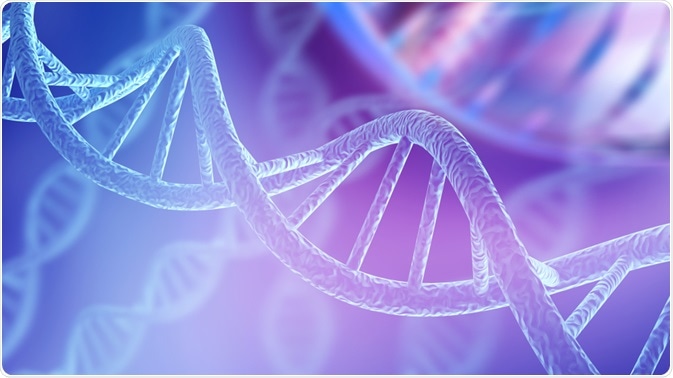DNA vaccines, which are often referred to as the third-generation vaccines, use engineered DNA to induce an immunologic response in the host against bacteria, parasites, viruses, and potentially cancer.
 Image Credit: Billion Photos/Shutterstock.com
Image Credit: Billion Photos/Shutterstock.com
Traditional vaccines
The vaccines that are currently available to the global population include those for measles, mumps, rubella, seasonal influenza virus, tetanus, polio, Hepatitis B, cervical cancer, diphtheria, pertussis as well as several other diseases that are endemic to certain regions of the world.
Many of these vaccines provide immunity by inducing antigen-specific adaptive immune responses in a naïve host.
More specifically, these vaccines expose the immune system to epitopes that originated from the target pathogen, which allows the immune system to develop antibodies that can recognize and attack this infectious agent if the vaccinated host encounters this pathogen in the future.
Although conventional vaccines are crucial for preventing the spread of numerous highly infectious diseases, the manufacturing of these vaccines often requires that researchers handle live pathogens. Not only can the handling of these pathogens pose safety concerns for those developing the vaccine, but the risk of contamination by these pathogens is also of concern.
The challenges associated with the development of conventional vaccines have led to the investigation of several alternative vaccine approaches that could be used for both infectious and non-infectious diseases.
One alternative vaccine that has gained considerable attention is a DNA-based vaccine which is considered to be more stable, cost-efficient, and easier to handle than traditional vaccines.
How do DNA vaccines work?
Like any other type of vaccine, DNA vaccines induce an adaptive immune response. The basic working principle behind any DNA vaccine involves the use of a DNA plasmid that encodes for a protein that originated from the pathogen in which the vaccine will be targeted.
Plasmid DNA (pDNA) is inexpensive, stable, and relatively safe, thereby allowing this non-viral platform to be considered an excellent option for gene delivery. Some of the different virus vectors that have been used to source pDNA include onco-retroviruses, lentiviruses, adenoviruses, adeno-associated viruses, and Herpes simplex-1.
When an intramuscular (IM) injection of a DNA vaccine is administered, the pDNA will target myocytes. DNA vaccines can also be administered through a subcutaneous or intradermal injection, both of which will target keratinocytes. Regardless of the injection site, the pDNA will transfect myocytes or keratinocytes, which will then undergo a type of programmed cell death known as apoptosis.
A cell that undergoes apoptosis will release small membrane-bound fragments that are otherwise known as apoptotic bodies, which trigger the endocytosis of cellular debris by immature dendritic cells (iDC). The activity of iDC can then initiate the generation of exogenous antigens, which are exclusively presented by major histocompatibility class II (MHCII).
Antigen presentation to MHCII activates helper CD4+ T cells, which contribute to B cell priming and ultimately allow for the humoral immune response to be created. This humoral immune response is required to activate the production of CD8+ T cells.
In addition to acting on either myocytes or keratinocytes, any DNA vaccine administration route can also transfect antigen-presenting cells (APCs) located near the injection site. This direct transfection route results in endogenous transgene expression and parallel presentation of the antigen through both MHCI and MHCII, thereby yielding both CD8+ and CD4+ T cells.
 Image Credit: New Africa/Shutterstock.com
Image Credit: New Africa/Shutterstock.com
What DNA vaccines are currently in development?
Currently, there are no DNA vaccines that have been approved for widespread use in humans. However, several DNA-based vaccines have been approved by both the United States Food and Drug Administration (FDA) and the United States Department of Agriculture (USDA) for veterinary use, of which include a vaccine against West Nile Virus in horses as well as a melanoma vaccine for dogs.
Although DNA-based vaccines have not yet been approved for use in the general public, several ongoing human clinical trials on DNA vaccines exist. According to the U.S. National Library of Medicine, over 160 different DNA vaccines are currently being tested in human clinical trials in the United States. It is estimated that 62% of these trials are devoted to cancer vaccines and 33% are applied for vaccines against human immunodeficiency virus (HIV).
One of the first clinical trials on a DNA vaccine investigated the potential therapeutic and prophylactic effects of a DNA vaccine against HIV. Although some level of immunogenicity was detected in this trial, no significant immune responses were found to arise. The hypervariability of HIV allows this virus to invade the host immune system through several different mechanisms.
As a result, scientists seeking to develop a DNA-based vaccine against HIV have discovered that several different priming strategies, boosting agents, and altered injection schedules must be carefully evaluated to design the best DNA vaccine against HIV.
Future directions
Even though numerous DNA-based vaccines are currently being tested in humans around the world, several challenges still stand in the way of allowing this vaccine approach to be translated into the clinic. One of the biggest challenges associated with DNA vaccines is their low immunogenicity in larger animals and humans.
Researchers believe that higher amounts of DNA within the range of 5 to 20 mg would need to be injected into an average-sized human to increase the immunogenicity of DNA-based vaccines. Another challenge of DNA-based vaccines involves the optimization of transfection, which could be achieved through the incorporation of several parameters such as a hybrid viral/eukaryotic promotor or the optimization of antigen codons.
Taken together, an ideal DNA vaccine will avoid extracellular degradation and successfully enter the nucleus of target cells to induce a long-term immune response.
References
- Malonis R.J., Lai J.R., Vergnolle O. (2020). Peptide-Based Vaccines: Current Progress and Future Challenges. Chemical Reviews 20(6);3210-3229. doi:10.1021/acs.chemrev.9b00472.
- Hobernik, D., & Bros, M. (2018). DNA Vaccines – How Far From Clinical Use? International Journal of Molecular Sciences 19(11). doi:10.3390/ijms19113605.
- Jahanafrooz, Z., Baradaran, B., Mosafer, J., et al. (2020). Comparison of DNA and mRNA vaccines against cancer. Drug Discovery Today 25(3); 552-560. doi:10.1016/j.drudis.2019.12.003.
- Rezaei, T., Khalili, S., Baradaran, B., et al. (2019). Recent advances on HIV DNA vaccines development: Stepwise improvements to clinical trials. Journal of Controlled Release 316; 116-137. doi:10.1016/j.jconrel.2019.10.045.
Further Reading
Last Updated: Mar 17, 2021